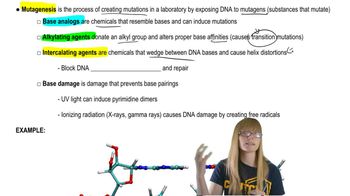- 1. Introduction to Genetics51m
- 2. Mendel's Laws of Inheritance3h 37m
- 3. Extensions to Mendelian Inheritance2h 41m
- 4. Genetic Mapping and Linkage2h 28m
- 5. Genetics of Bacteria and Viruses1h 21m
- 6. Chromosomal Variation1h 48m
- 7. DNA and Chromosome Structure56m
- 8. DNA Replication1h 10m
- 9. Mitosis and Meiosis1h 34m
- 10. Transcription1h 0m
- 11. Translation58m
- 12. Gene Regulation in Prokaryotes1h 19m
- 13. Gene Regulation in Eukaryotes44m
- 14. Genetic Control of Development44m
- 15. Genomes and Genomics1h 50m
- 16. Transposable Elements47m
- 17. Mutation, Repair, and Recombination1h 6m
- 18. Molecular Genetic Tools19m
- 19. Cancer Genetics29m
- 20. Quantitative Genetics1h 26m
- 21. Population Genetics50m
- 22. Evolutionary Genetics29m
Xeroderma pigmentosum (XP) is an autosomal recessive condition characterized by moderate to severe sensitivity to ultraviolet (UV) light. Patients develop multiple skin lesions on UV-exposed skin, and skin cancers often develop as a result. XP is caused by deficient repair of DNA damage from UV exposure.
A series of 10 skin-cell lines was grown from different XP patients. Cells from these lines were fused, and the heterokaryons were tested for genetic complementation by assaying their ability to repair DNA damage caused by a moderate amount of UV exposure. In the table below, '+' indicates that the fusion cell line performs normal DNA damage mutation repair, and '−' indicates defective DNA repair. Use this information to determine how many DNA-repair genes are mutated in the 10 cell lines, and identify which cell lines share the same mutated genes.
 Verified Solution
Verified Solution
